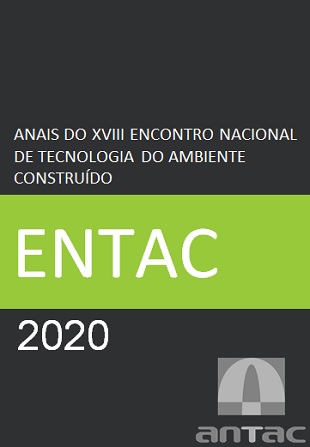PRODUÇÃO DE TIJOLOS SOLO-CIMENTO: AVALIAÇÃO DO CICLO DE VIDA E SUA CONTRIBUIÇÃO PARA O DESEMPENHO DE PRODUTOS ECOEFICIENTES
DOI:
https://doi.org/10.46421/entac.v18i.988Keywords:
NBR 15575, Ecological Brick, Environmental Management, SustainabilityAbstract
With technological advances and the use of new materials in the field of civil construction, it was necessary to create conditions to validate the quality of the works, in 2013, the ABNT NBR 15575 emerged, a standard that requires requirements, criteria and evaluation methods for the validation of the performance of residential buildings. Through the performance standard it is possible to meet the most varied requirements of users for this type of environment; among these calls, those related to sustainability stand out, which aim at specifying and obtaining components, elements and systems in the homes that contribute to the mitigation of environmental impacts, an example of eco-efficient materials, such as soil-cement bricks. The Life Cycle Assessment (LCA) is an environmental management tool that aims to identify a stage that most impacts the environment, being used in this study as a method for assessing sustainability requirements. Based on the estimated results, the Life Cycle Assessment for soilcement bricks is efficient as to the objective proposed in the research
References
ALBUQUERQUE, Hiago Ribeiro; LIRA, Júlia; SPOSTO, Rosa Maria. Emissões de CO2 de sistemas de revestimento de argamassa: estudo de caso de aplicação de argamassa projetada comparativamente à aplicação convencional. Ambiente Construído, v. 18, n. 4, p. 377-393, 2018. Disponível em: <http://www.scielo.br/pdf/ac/v18n4/1678-8621-ac-18-04-0377.pdf>. Acesso em: 17 dez. 2019.
ASSOCIAÇÃO BRASILEIRA DE NORMAS TÉCNICAS (ABNT). NBR 15575 - 1: Desempenho de Edifícios Habitacionais. Rio de Janeiro, 2013.
______. NBR ISO 14040: Gestão ambiental: avaliação do ciclo de vida: princípios e estrutura. Rio de Janeiro, 2009.
BRASIL, MMA. 2º Inventário Nacional de Emissões Atmosféricas por Veículos Automotores Rodoviários 2013–Ano-base 2012: Relatório final. MMA, Brasília, DF, Brasil, 2014. Disponível em: <http://www.antt.gov.br/backend/galeria/arquivos/inventario_de_emissoes_por_veiculos_rodoviarios_2013.pdf>. Acesso em: 05 fev. 2020.
CALDAS, Lucas Rosse; SPOSTO, Rosa Maria. Emissões de CO2 referentes ao transporte de materiais de construção no Brasil: estudo comparativo entre blocos estruturais cerâmicos e de concreto. Ambiente Construído, v. 17, n. 4, p. 91-108, 2017. Disponível em: <http://www.scielo.br/pdf/ac/v17n4/1678-8621-ac-17-04-0091.pdf>. Acesso em: 03 nov. 2019.
CAVALCANTI, Ana Luisa Boavista Lustosa et al. Design para a Sustentabilidade: um conceito Interdisciplinar em construção. Projetica, v. 3, n. 1, p. 252-263, 2012. Disponível em: <http://www.uel.br/seer/index.php/projetica/article/download/12384/11341>. Acesso em: 15 jan. 2020.
CUNHA, Iasminy Borba da et al. Quantificação das emissões de CO2 na construção de unidades residenciais unifamiliares com diferentes materiais. 2016. Disponível em: < http://tede2.pucrs.br/tede2/bitstream/tede/6884/2/DISIASMINYBORBADACUNHA COMPLETO.pdf>. Acesso em: 03 de nov. 2019.
GOOGLE. Google Earth. [Terra]. Disponível em: < https://www.google.com.br/earth/ download/gep/agree.html>. Acesso em: 10 mar. 2020.
GOOGLE. Google Maps. [Mapa]. Disponível em: <https://www.google.com.br/maps/@-18.9141245,-41.9890617,15z?hl=en>. Acesso em: 10 mar. 2020.
LEAL JUNIOR, Ilton Curty et al. ANÁLISE DA MATRIZ DE TRANSPORTE BRASILEIRA: CONSUMO DE ENERGIA E EMISSÃO DE CO2. Revista Uniabeu, v. 8, n. 18, p. 49-64, 2015. Disponível em:<https://revista.uniabeu.edu.br/index.php/RU/article/view/1509 >. Acesso em: 12 fev. 2020.
MOTTA, Jessica Campos Soares Silva et al. Tijolo de solo-cimento: análise das características físicas e viabilidade econômica de técnicas construtivas sustentáveis. e-xacta, v. 7, n. 1, p.
13-26, 2014. Disponível em:< https://revistas.unibh.br/dcet/article/viewFile/1038/665>. Acesso em: 02/03/2020.
OLIVEIRA, Josiane Rodrigues de; AMARAL, Adriana Garcia do; SCHNEIDER, Roselene Maria.
Incorporação de Resíduos Sólidos na Fabricação de Tijolos Solo-Cimento. Nativa, v. 2, n. 1, p.
53-57, 2014. Disponível em: <http://periodicoscientificos.ufmt.br/ojs/index.php/nativa/article/view/1370>. Acesso em: 28 out. 2019.
POSSAN, Edna; DEMOLINER, Carlos Alberto. Desempenho, durabilidade e vida útil das edificações: abordagem geral. Revista técnico-científica, v. 1, n. 1, 2013. Disponível em: <http://creaprw16.creapr.org.br/revista/Sistema/index.php/revista/article/view/14/10>. Acesso em 04 nov. 2019.
SEGANTINI, AA da S., & WADA, PH (2011). Uma avaliação da composição de tijolos de cimento no solo com resíduos de construção e demolição b & gt; - doi: 10.4025 / actascitechnol.v33i2.9377. Acta Scientiarum. Technology , 33 (2), 179-183. Disponível em: <https://doi.org/10.4025/actascitechnol.v33i2.9377>. Acesso em: 28 jan. 2020.
TAVARES, Sérgio Fernando. Metodologia de análise do ciclo de vida energéticode edificações residenciais brasileiras. Florianópolis, 2006. 225 p. Tese(Doutorado em Tecnologia). Universidade Federal de Santa Catarina, Brasil. Disponível em: <https://repositorio.ufsc.br/bitstream/handle/123456789/89528/236520.pdf?sequence>. Acesso em: 28 out. 2019.

